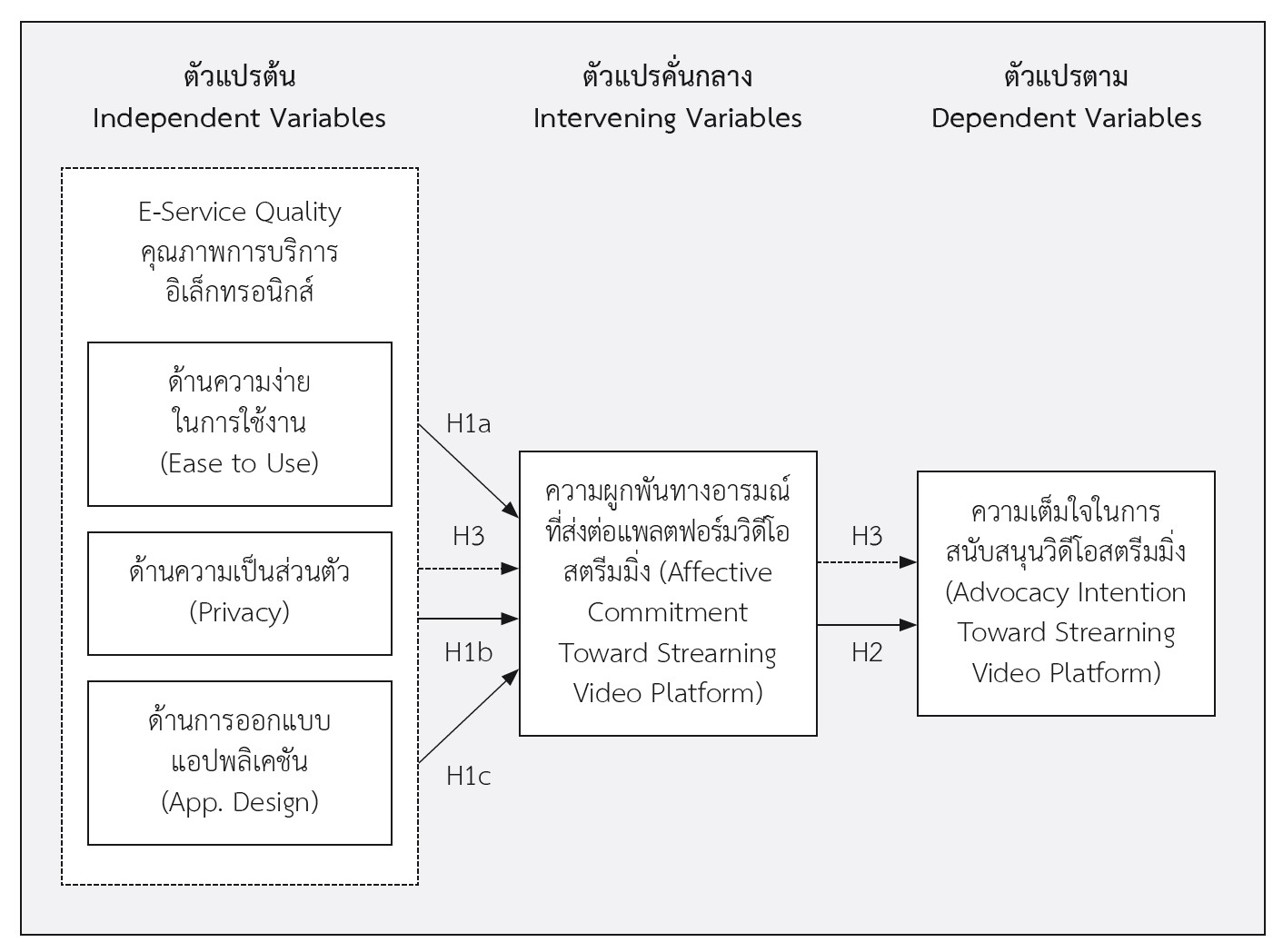อิทธิพลของคุณภาพการบริการที่มีต่อความผูกพันทางอารมณ์ และความเต็มใจในการสนับสนุนแพลตฟอร์มวิดีโอสตรีมมิ่ง
คำสำคัญ:
คุณภาพการบริการอิเล็กทรอนิกส์, แพลตฟอร์มวิดีโอสตรีมมิ่ง , ความเต็มใจสนับสนุนบทคัดย่อ
การวิจัยนี้มีวัตถุประสงค์เพื่อศึกษาอิทธิพลของคุณภาพการบริการอิเล็กทรอนิกส์ที่มีต่อความผูกพันทางอารมณ์และความเต็มใจในการสนับสนุนแพลตฟอร์มวิดีโอสตรีมมิ่งของกลุ่มผู้บริโภค Generation Z โดยมีกลุ่มตัวอย่างที่ใช้ในการศึกษางานวิจัยครั้งนี้จำนวน 405 คน เป็นผู้ที่มีอายุระหว่าง 18-24 ปี และเก็บรวบรวมข้อมูลโดยใช้แบบสอบถามออนไลน์ จากนั้นนำข้อมูลมาทดสอบสมมติฐานโดยการวิเคราะห์การถดถอยพหุคูณ (Multiple linear regression) และวิเคราะห์อิทธิพลของตัวแปรคั่นกลางการวิเคราะห์เส้นทาง ผลการศึกษา พบว่า ปัจจัยความง่ายในการใช้งาน ความเป็นส่วนตัว และการออกแบบแอปพลิเคชัน ส่งผลเชิงบวกต่อความผูกพันทางอารมณ์อย่างมีนัยสำคัญทางสถิติ รวมถึงความผูกพันทางอารมณ์ก็ส่งผลต่อความเต็มใจในการสนับสนุนเช่นกัน การศึกษาครั้งนี้ยังวิเคราะห์ผลกระทบโดยตรงและโดยอ้อม เพื่อทดสอบอิทธิพลของตัวแปรคั่นกลาง พบว่า ปัจจัยความง่ายในการใช้งาน ความเป็นส่วนตัว และการออกแบบแอปพลิเคชันมีอิทธิพลต่อความเต็มใจในการสนับสนุนแพลตฟอร์มวิดีโอสตรีมมิ่ง โดยมีความผูกพันทางอารมณ์เป็นตัวแปรคั่นกลางที่มีอิทธิพลบางส่วน (Partial mediation) การศึกษานี้เป็นประโยชน์สำหรับผู้ประกอบการเพื่อนำไปประยุกต์ใช้วางแผนพัฒนากลยุทธ์ทางการตลาดเพื่อตอบสนองความต้องการของผู้บริโภคเชิงอารมณ์
เอกสารอ้างอิง
Aaker, J., Fournier, S., & Brasel, S. A. (2004). When good brands do bad. Journal of Consumer research, 31(1), 1-16. https://doi.org/10.1086/383419
Amani, Z. (2015). Commitment as a mediator of the relationship between trust and relationship loyalty to retailer. Journal of Business Studies Quarterly, 6(3), 144- 163.
Burgoon, J. K., Parrott, R., Le Poire, B. A., Kelley, D. L., Walther, J. B., & Perry, D. (1989). Maintaining and restoring privacy through communication in different types of relationships. Journal of social and personal relationships, 6(2), 131-158. https://doi.org/10.1177/026540758900600201
Cervera, M., Albert, M., Torres, V., & Pelechano, V. (2015). On the usefulness and ease of use of a model-driven Method Engineering approach. Information systems, 50, 36-50. https://doi.org/10.1016/j.is.2015.01.006
Chitareeratana, R. (2021). Analysis of the Booking.com Application Design that affects Actual Use of Users in Thailand. (Master's independent study). Bangkok university.
Clemes, M.D, Shu, X. and Gan, C. (2014). Mobile communications: a comprehensive hierarchical modeling approach. Asia Pacific Journal of Marketing and Logistics, 26(1), 114-146. https://doi.org/10.1108/APJML-04-2013-0040
Cochran, W. G. (1977). Sampling techniques (3rd ed.). New York: John Wiley & Sons.
Culnan, M. J., & Armstrong, P. K. (1999). Information privacy concerns, procedural fairness, and impersonal trust: An empirical investigation. Organization science, 10(1), 104-115. https://doi.org/10.1287/orsc.10.1.104
Dabholkar, P. A. (1996). Consumer evaluations of new technology-based self-service options: an investigation of alternative models of service quality. International Journal of research in Marketing, 13(1), 29-51. https://doi.org/10.1016/0167-8116(95)00027-5
Demir, A., Maroof, L., Sabbah Khan, N. U., & Ali, B. J. (2021). The role of E-service quality in shaping online meeting platforms: a case study from higher education sector. Journal of Applied Research in Higher Education, 13(5), 1436-1463. https://doi.org/10.1108/JARHE-08-2020-0253
Dinev, T., & Hart, P. (2006). An extended privacy calculus model for e-commerce transactions. Information systems research, 17(1), 61-80. https://doi.org/10.1287/isre.1060.0080
Dumbill, E. (2012). What is big data. An introduction to the big data landscape. Strata. http://strata.oreilly. com/2012/01/what-is-big-data. html.
Fassnacht, M., & Koese, I. (2006). Quality of electronic services: Conceptualizing and testing a hierarchical model. Journal of service research, 9(1), 19-37. https://doi.org/10.1177/1094670506289531
Fournier, S. (1998). Consumers and their brands: Developing relationship theory in consumer research. Journal of consumer research, 24(4), 343-373. https://doi.org/10.1086/209515
Fuggetta, Rob. Brand advocates: Turning enthusiastic customers into a powerful marketing force. John Wiley & Sons, 2012.
Fullerton, G. (2003). When does commitment lead to loyalty?. Journal of service research, 5(4), 333-344. https://doi.org/10.1177/1094670503005004005
Fungsirirat, P., & Piriyakul, I. (2021). Consumer behavioral analysis on streaming video using the conjoint analysis technique. (Doctoral dissertation). Srinakharinwirot University.
Harrison-Walker, L. J. (2001). The measurement of word-of-mouth communication and an investigation of service quality and customer commitment as potential antecedents. Journal of service research, 4(1), 60-75. https://doi.org/10.1177/109467050141006
Herr, P. M., Kardes, F. R., & Kim, J. (1991). Effects of word-of-mouth and product-attribute information on persuasion: An accessibility-diagnosticity perspective. Journal of consumer research, 17(4), 454-462. https://doi.org/10.1086/208570
Hung, K. H., & Li, S. Y. (2007). The influence of eWOM on virtual consumer communities: Social capital, consumer learning, and behavioral outcomes. Journal of advertising research, 47(4), 485-495. https://doi.org/10.2501/S002184990707050X
Keh, H. T., Nguyen, T. T. M., & Ng, H. P. (2007). The effects of entrepreneurial orientation and marketing information on the performance of SMEs. Journal of business venturing, 22(4), 592-611. https://doi.org/10.1016/j.jbusvent.2006.05.003
Keller, E. (2007). Unleashing the power of word of mouth: Creating brand advocacy to drive growth. Journal of advertising research, 47(4), 448-452. https://doi.org/10.2501/S0021849907070468
Keller, K. L. (1993). Conceptualizing, measuring, and managing customer-based brand equity. Journal of marketing, 57(1), 1-22. https://doi.org/10.1177/002224299305700101
Khraiwish, A., Al-Gasawneh, J., Joudeh, J., Nusairat, N., & Alabdi, Y. (2022). The differential impacts of customer commitment dimensions on loyalty in the banking sector in Jordan: Moderating the effect of e-service quality. International Journal of Data and Network Science, 6(2), 315-324. https://doi.org/10.5267/j.ijdns.2022.1.006
Kim, W. G., Han, J. S., & Lee, E. (2001). Effects of relationship marketing on repeat purchase and word of mouth. Journal of Hospitality & Tourism Research, 25(3), 272-288. https://doi.org/10.1177/109634800102500303
Li, H., & Suomi, R. (2009). A proposed scale for measuring e-service quality. International Journal of u-and e-Service, Science and Technology, 2(1), 1-10. https://doi.org/10.14257/ijunesst.2018.11.1.01
Li, H., Sarathy, R., & Xu, H. (2011). The role of affect and cognition on online consumers' decision to disclose personal information to unfamiliar online vendors. Decision Support Systems, 51(3), 434-445. https://doi.org/10.1016/j.dss.2011.01.017
Liu, S. (2012). The impact of forced use on customer adoption of self-service technologies. Computers in Human Behavior, 28(4), 1194-1201. https://doi.org/10.1016/j.chb.2012.02.002
McQueen, M. (2011). Ready or not... here come Gen Z: A look at the generation about to hit high schools, workplaces and society-at-large. LinkedIn. https://www.linkedin.com/pulse/ready-here-come-gen-z-michael-mcqueen
McQueen, M. (2011). Ready or not...here come gen Z. http://michaelmcqueen.net/phocadownload/ parents-teachers/ Ready%20or%20not.%20here%20come%20Gen%20Z.pdf
Nunnally, J. C. (1978). An overview of psychological measurement. Clinical diagnosis of mental disorders: A handbook, 97-146. https://doi.org/10.1007/978-1-4684-2490-4_4
Oliveira, P., Roth, A.V., and Gilland, W. (2002). Achieving competitive capabilities in e-services, Technological Forecasting & Social Change, 69, 721-739. https://doi.org/10.1016/S0040-1625(01)00188-3
Oloveze, Ambrose & Oteh, Ogbonnaya & Nwosu, Hyginus & Obasi, Ray. (2021). How user behaviour is moderated by affective commitment on point-of-sale terminal. Rajagiri Management Journal. ahead-of-print. 10.1108/RAMJ-05-2020-0019.
https://doi.org/10.1108/RAMJ-05-2020-0019
Palley, W. (2012). Gen Z: Digital in their DNA. New York: JWT Intelligendce.
Palwat, W. (2022). Factors in Video Streaming Application Design Influencing Users' Satisfaction and Loyalty in Thailand. (Master's thesis). Mahidol University.
Parasuraman, A., Zeithaml, V. A., & Malhotra, A. (2005). ES-QUAL: A multiple-item scale for assessing electronic service quality. Journal of service research, 7(3), 213-233. https://doi.org/10.1177/1094670504271156
Park, C. W., & MacInnis, D. J. (2006). What's in and what's out: Questions on the boundaries of the attitude construct. Journal of consumer Research, 33(1), 16-18. https://doi.org/10.1086/504122
Perera, C., Ranjan, R., Wang, L., Khan, S. U., & Zomaya, A. Y. (2015). Big data privacy in the internet of things era. IT Professional, 17(3), 32-39. https://doi.org/10.1109/MITP.2015.34
Phiraphon, T. (2018). User Experience Design of Artificial Intelligent Technology. Journal of Science and Technology, 12(1), 39-45.
Pinyopanichkan, P. (2020). The relationship between electronic service quality and the loyalty of Netflix streaming users. (Master's thesis). Srinakharinwirot University.
Ramya, N., Kowsalya, A., & Dharanipriya, K. (2019). Service quality and its dimensions. EPRA International Journal of Research & Development, 4(2), 38-41.
Reichheld, F. F. (1996). Learning from customer defections. Harvard business review, 74(2), 56-67.
Ruengpraphan, C. (2000). Fundamental Statistics: Example of Miniteb SPSS and SAS Analysis. Khonkaen. Khonkaen University Press.
Schweidel, D. A., & Moe, W. W. (2016). Binge watching and advertising. Journal of Marketing, 80(5), 1-19. https://doi.org/10.1509/jm.15.0258
Shin, D. H. (2010). The effects of trust, security, and privacy in social networking: A security-based approach to understand the pattern of adoption. Interacting with computers, 22(5), 428-438. https://doi.org/10.1016/j.intcom.2010.05.001
Silavisetrit, P. (2012). A study of the relationship integrated marketing communications (IMC) and buying decision stages of eco-products among generation Y customers in Bangkok. (Master's independent study). Bangkok university.
Snyder, J. L., & Cistulli, M. D. (2011). The relationship between workplace e-mail privacy and psychological contract violation, and their influence on trust in top management and affective commitment. Communication Research Reports, 28(2), 121-129. https://doi.org/10.1080/08824096.2011.565270
Stuart-Menteth, H., Wilson, H., & Baker, S. (2006). Escaping the channel silo-researching the new consumer. International Journal of Market Research, 48(4), 415-437. https://doi.org/10.1177/147078530604800405
Suh, B., & Han, I. (2003). The impact of customer trust and perception of security control on the acceptance of electronic commerce. International Journal of electronic commerce, 7(3), 135-161. https://doi.org/10.1080/10864415.2003.11044270
Suphatwanich, P. (2021). HILL ASEAN เจาะลึกพฤติกรรม Gen Z กว่า 24 % ในภูมิภาคอาเซียนกับนิยามใหม่ "The SynergiZers". Siamrath. https://siamrath.co.th/n/236862
Thanitthanakorn, N. (2019). Experiential Relationship Strategy Affecting Customers' Decision to Use Financial Products at Krungthai Bank Public Company Limited in Suphanburi Province. (Master's independent study). Bangkok university.
The National Broadcasting and Telecommunication Commission. (2020). Changes in media: cut or co(operation). NBTC. https://broadcast.nbtc.go.th/data/academic/file/630300000002.pdf
Uitekeng, W. (2015). Online Marketing Communication Strategy of Online Business in Terms of Streaming in Thailand. (Master's independent study). Bangkok university.
Veloutsou, C., & Moutinho, L. (2009). Brand relationships through brand reputation and brand tribalism. Journal of Business Research, 62(3), 314-322. https://doi.org/10.1016/j.jbusres.2008.05.010
White, S. S., & Schneider, B. (2000). Climbing the commitment ladder: the role of expectations disconfirmation on customers' behavioral intentions. Journal of Service Research, 2(3), 240-253. https://doi.org/10.1177/109467050023002
Wood, S. (2013). Generation Z as consumers: trends and innovation. Institute for Emerging Issues: NC State University, 119(9), 7767-7779.
Yang, Z. (2001). Measuring e-service quality and its linkage to customer loyalty. New Mexico State University.

ดาวน์โหลด
เผยแพร่แล้ว
รูปแบบการอ้างอิง
ฉบับ
ประเภทบทความ
สัญญาอนุญาต
ลิขสิทธิ์ (c) 2023 คณะบริหารธุรกิจ สถาบันบัณฑิตพัฒนบริหารศาสตร์

อนุญาตภายใต้เงื่อนไข Creative Commons Attribution-NonCommercial-NoDerivatives 4.0 International License.



